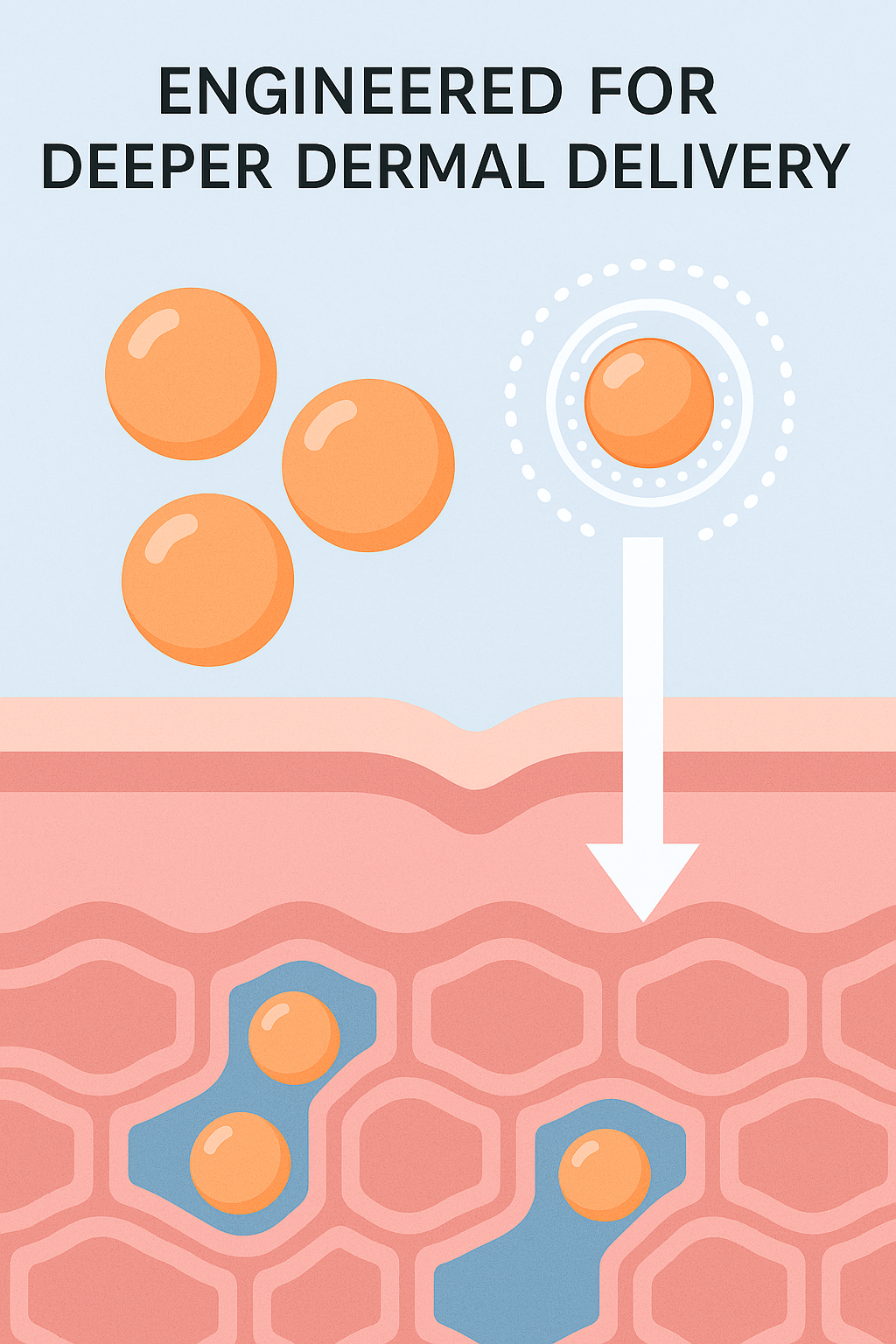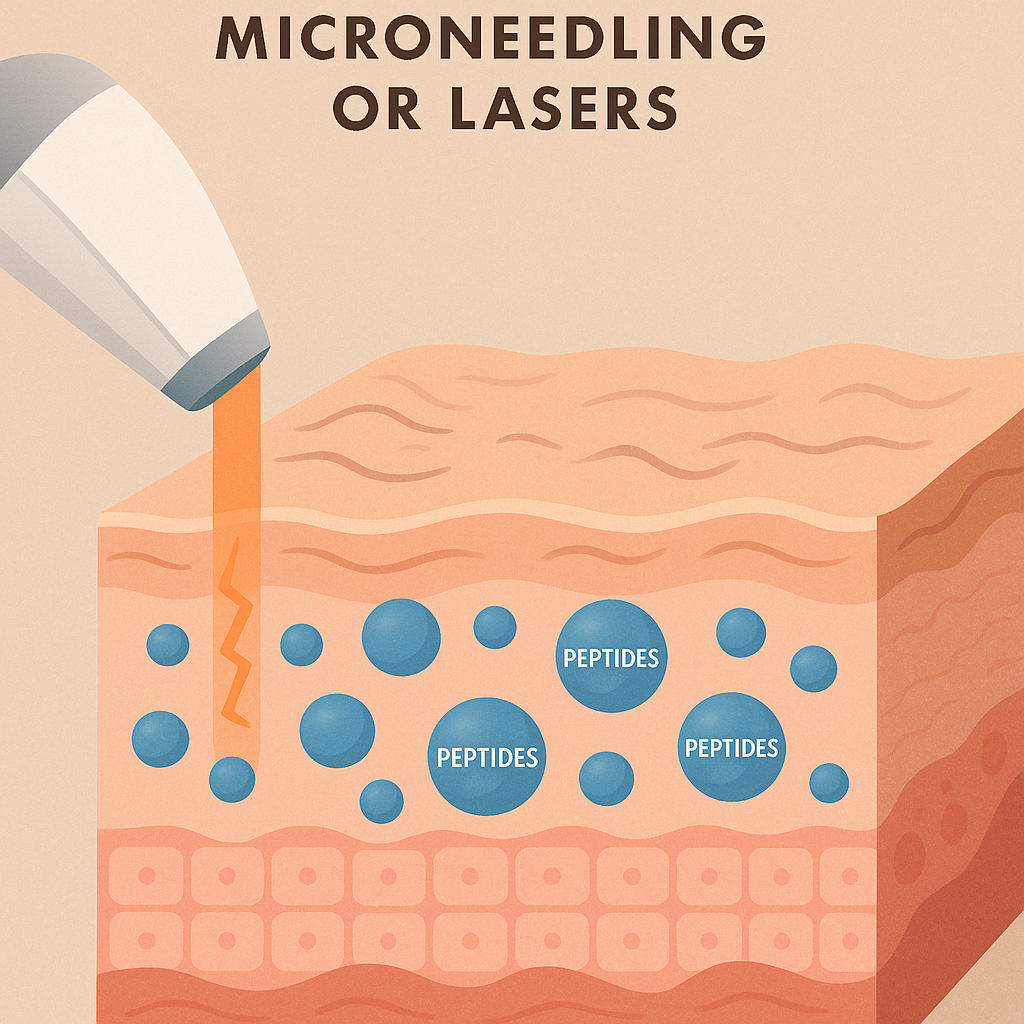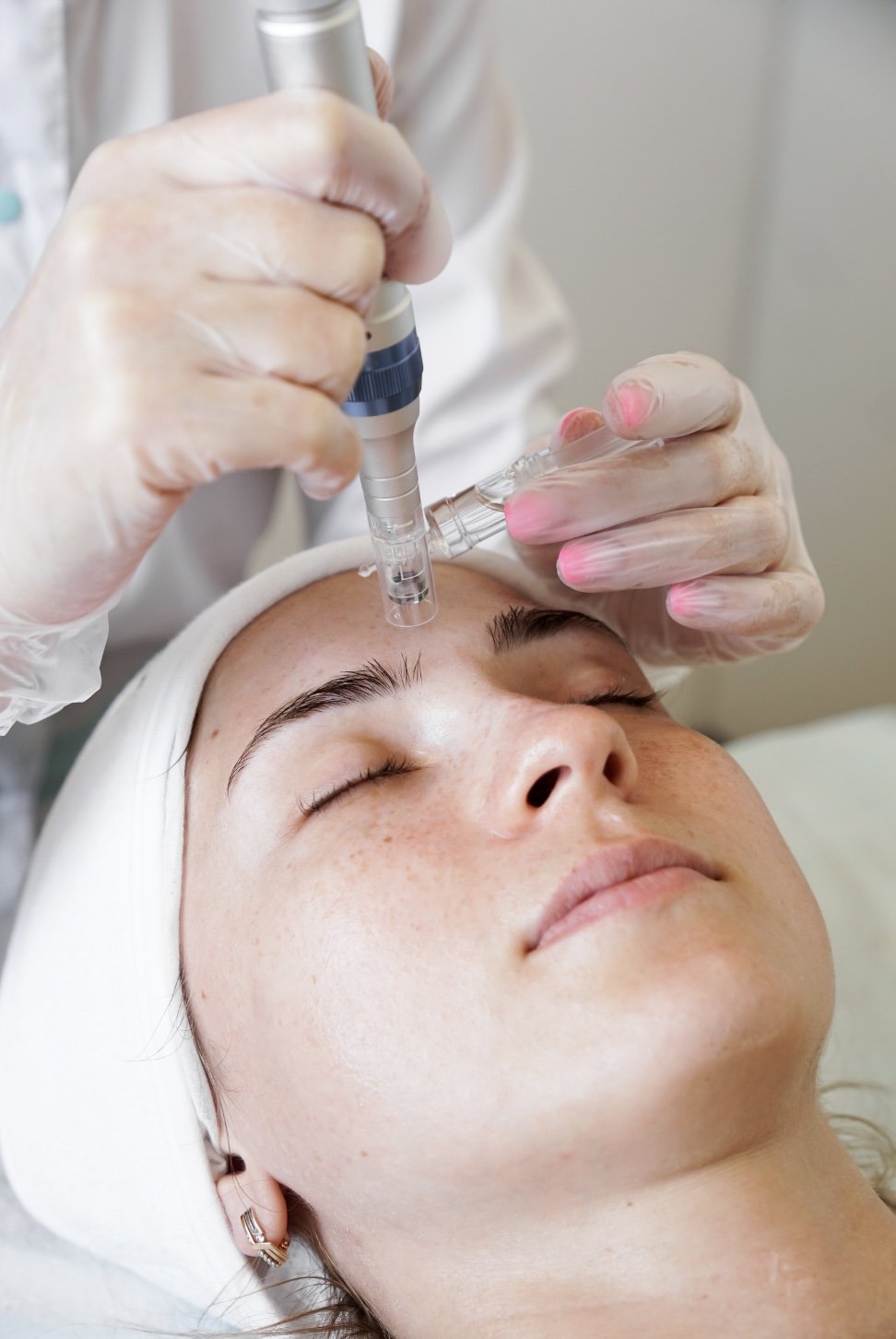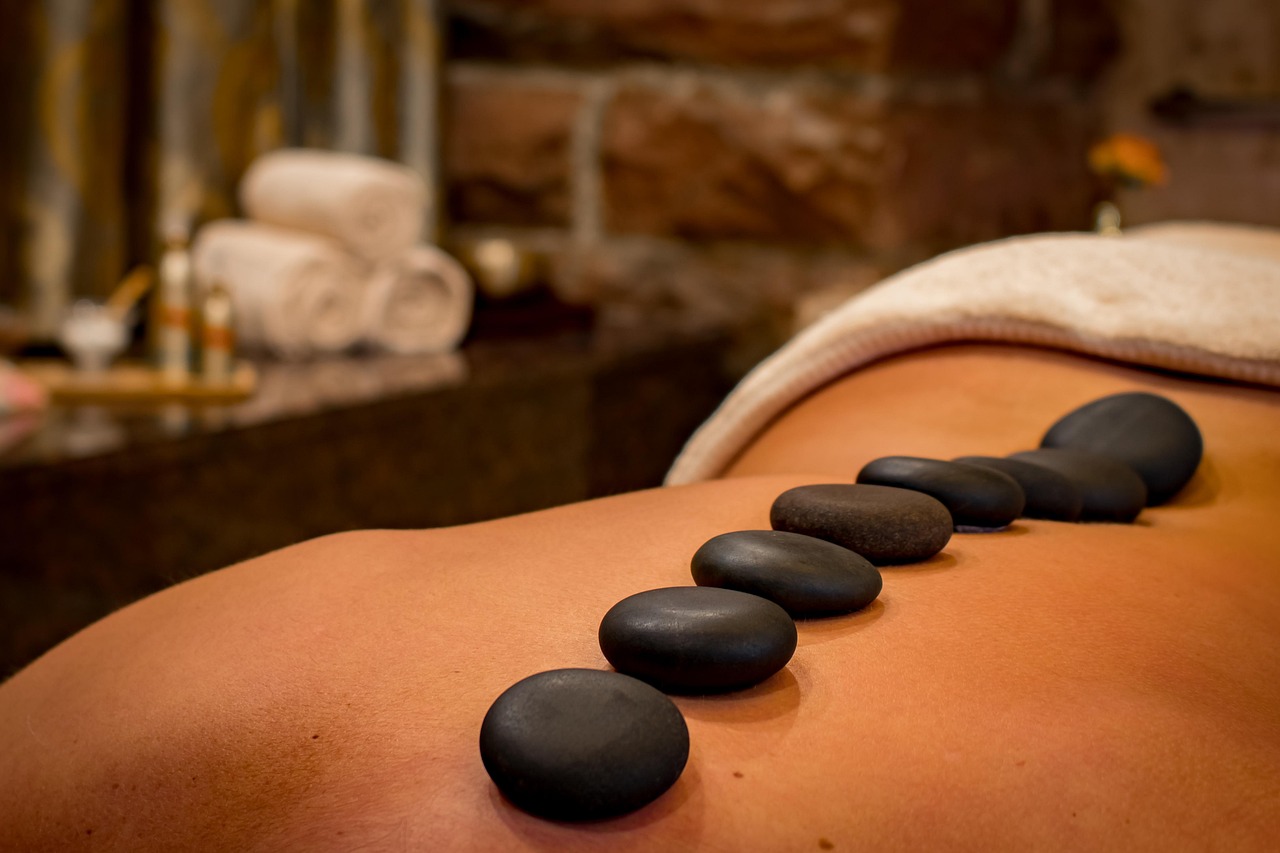Peptides have become undeniable superstars in skincare. Every other new launch promises to revolutionize your complexion with these tiny but mighty protein fragments. However, with so many marketing claims circulating in the beauty industry, it’s easy to get lost in the hype. You’re likely asking: beyond the buzzwords, what peptides do for the skin? And how do we tell the scientific truths from the clever marketing? Let’s decode the most common claims about peptides. From claims about their penetration to their performance, and all those exciting anti-aging promises in between.
1. Small enough to penetrate the skin barrier
Partially true
This claim is the majority of the reason peptides are such popular actives in skincare and beauty. Penetration through the skin barrier is a challenge for any topical ingredient, and peptides are not exempt just because they are small. While peptides are smaller than collagen molecules, they still have challenges getting through your skin barrier. Most peptides are larger than the commonly referenced 500 Dalton rule for passive skin penetration, and they’re largely hydrophilic (water-loving). This means their ability to easily glide across the skin’s barrier without help is minimal. For example, in one 24-hour test using a basic cream, less than 0.01% of a peptide like Argireline actually managed to get to the deeper layers of your skin where it needs to reach to be effective.

So, when discussing what peptides do for the skin, their journey into the skin is really important. But don’t worry its not all doom and gloom! Products that a well formulated and with good delivery systems can make sure the peptides get where they need to go. When you are looking for your next peptide product, look at the brand’s website and see if they have any clinical results to support their claims. This is the best way up your chances of getting the results you are paying for.
2. Engineered for deeper dermal delivery
True, for some, not all
This marketing claim can be true if the delivery system is not just a standard cream or serum. Cosmetic chemists have done some amazing work, developing unique strategies to trick your skin into letting important actives through. Whether it’s adding a special molecule to the active or encapsulating the actives like a Trojan horse, they are designed to significantly improve a peptide’s ability to penetrate. Peptides like Matrixyl® (palmitoyl pentapeptides) are classic examples. They have fatty acids attached to boost their uptake. So it is possible for a peptide to be engineered for deeper dermal delivery, but again it’s a good idea to check a brand’s website to see what data they have to support this marketing claim.

3. Cell-penetrating peptides (CPPs)
An exciting, emerging field with some scientific backing, but not clinically proven
Certain peptides, such as GHK-Cu, are sometimes categorized as ‘carrier peptides,’ and the broader concept of Cell-Penetrating Peptides (CPPs) for delivering actives directly into cells is a rapidly evolving area of research. While the promise is really exciting, robust human clinical data specifically demonstrating their “cargo transport” ability for all skincare actives is limited. Their current, most validated value is still in targeted cellular interactions and guiding anti-inflammatory behavior of cells. However, if this breakthrough does transition to the skincare mass market, it would influence what peptides do for the skin at a foundational level.Additionally, this would be a drug claim, and cosmetic companies should not be making it. So I would stay away from any brands selling a product as a cosmetic but making drug claims.
4. Benefits are enhanced with in office procedures like microneedling or lasers
True, resoundingly supported by clinical evidence.
Here, the science is clear: combining peptides with procedures like microneedling or certain laser treatments dramatically boosts their delivery and, consequently, their efficacy. A compelling 2019 Korean trial, for instance, demonstrated that dissolvable microneedle patches infused with Argireline led to significantly superior wrinkle reduction compared to placebo patches. This highlights a powerful synergy for what peptides do for the skin when delivery is optimized.

5. There are peptides that are “Botox-like” or “Botox in a jar”
Some truth, but VERY exaggerated and overstated.
Peptides such as Argireline and acetyl octapeptide-3 do indeed offer a milder, topical alternative to Botox. They do this by partially mimicking proteins that are involved in muscle contraction. They prevent muscle contraction that contributes to expression lines. However, they absolutely do not paralyze muscles in the way Botox does. The results are typically gentler, more gradual, require consistent use and temporary. People usually notice a difference within 4–8 weeks of consistent use. Understanding this nuance is key to realistic expectations about what peptides do for the skin.
6. Peptides can support skin repair & barrier function
Strongly backed by evidence.
This is another area where peptides truly shine. Copper peptides (GHK-Cu) and certain Matrixyl peptides are known for their profound ability to enhance wound healing, fortify the skin’s protective barrier, and improve overall hydration. This leads to a more resilient and healthier complexion over time, showcasing a vital aspect of what peptides do for the skin.
7. Best in serums (deepest delivery), then creams, masks
Highly consistent with scientific findings.
The lighter, often more concentrated formulations of serums, especially those utilizing cutting-edge nano-carriers or emulsions, are generally designed to enhance ingredient delivery compared to heavier creams or masks, which tend to create more occlusive layers on the skin’s surface.
8. Synergistic with vitamin C, niacinamide, retinol, hyaluronic acid
Plausible and common in high-performance formulations.
There are quite a few clinical studies evaluating peptide’s affect in formulations that combine peptides with other well known actives like hydrators (hyaluronic acid), antioxidants (vitamin C), or barrier support ingredients (niacinamide). While this can sometimes make it challenging to isolate the exact effects of the peptide alone, the observed benefits strongly suggest synergistic interactions that amplify what peptides do for the skin
9. The product is “backed by clinical studies”
Yes, for the key, well-established peptides.
The effectiveness of the most popular peptides like Argireline, Matrixyl (various forms), and GHK-Cu is indeed supported by science. With a growing body of peer-reviewed, placebo-controlled human trials their benefits are becoming more and more established. However, this does not mean every peptide marketing claim gets a pass. Not every single marketing claim you encounter will be directly tied to rigorous scientific research. As a discerning consumer, always look for brand’s research on their specific formulations. And if you cannot find it then ingredient specific data can be an alternative.
10. Consistent peptide use fills in fine lines and wrinkles
Supported visually, but its not literally “filling” like a dermal filler.
Peptides reduce the appearance of fine lines and wrinkles by fundamentally improving skin thickness, density, and hydration. They work from within to fortify the skin’s architecture. For instance, clinical studies have shown that Matrixyl® 3000 can reduce the deep wrinkle area by an impressive 44% in just 8 weeks, making a clear case for what peptides do for the skin’s texture.
The Final Word
Understanding what peptides do for the skin means looking beyond the glossy ads and delving into the real science of how they behave on and within your skin. Knowing their strengths, their delivery mechanisms, and what to expect realistically is key to unlocking their ability in your skincare routine. When you know what peptides do for the skin and how they get there, you’re empowered to make smarter, more effective skincare choices.
References
Aguilar-Toalá, J. E., Hernández-Mendoza, A., González-Córdova, A. F., Vallejo-Córdova, B., & Liceaga, A. M. (2019). Potential role of natural bioactive peptides for development of cosmeceutical skin products. Peptides, 122, 170170. https://doi.org/10.1016/j.peptides.2019.170170
Aldag, C., Teixeira, D. N., & Leventhal, P. S. (2016). Skin rejuvenation using cosmetic products containing growth factors, cytokines, and matrikines: A review of the literature. Clinical, Cosmetic and Investigational Dermatology, 9, 411–419. https://doi.org/10.2147/CCID.S116158
An, J. H., Lee, H. J., Yoon, M. S., & Kim, D. H. (2019). Anti-Wrinkle Efficacy of Cross-Linked Hyaluronic Acid-Based Microneedle Patch with Acetyl Hexapeptide-8 and Epidermal Growth Factor on Korean Skin. Annals of dermatology, 31(3), 263–271. https://doi.org/10.5021/ad.2019.31.3.263
Chen, J., Bian, J., Hantash, B. M., Albakr, L., Hibbs, D. E., Xiang, X., Xie, P., Wu, C., & Kang, L. (2021). Enhanced skin retention and permeation of a novel peptide via structural modification, chemical enhancement, and microneedles. International Journal of Pharmaceutics, 606, 120868. https://doi.org/10.1016/j.ijpharm.2021.120868
Cosmetic Ingredient Review Expert Panel. (2012). Safety assessment of palmitoyl oligopeptides as used in cosmetics. International Journal of Toxicology, 31(6 Suppl), 1S–14S.
Cosmetic Ingredient Review Expert Panel. (2020). Safety assessment of Acetyl Hexapeptide-8 and Acetyl Hexapeptide-8 Amide as used in cosmetics (Scientific Literature Review). Washington, DC: Cosmetic Ingredient Review. Retrieved from https://www.cir-safety.org/sites/default/files/acetyl122019SLR.pdf
Farwick, M., Grether-Beck, S., Marini, A., Maczkiewitz, U., Lange, J., Köhler, T., Lersch, P., Falla, T., Felsner, I., Brenden, H., Jaenicke, T., Franke, S., & Krutmann, J. (2011). Bioactive tetrapeptide GEKG boosts extracellular matrix formation: In vitro and in vivo molecular and clinical proof. Experimental Dermatology, 20(7), 602–604. https://doi.org/10.1111/j.1600-0625.2011.01307.x
Fu, J. J. J., Hillebrand, G. G., Raleigh, P., Li, J., Marmor, M. J., Bertucci, V., Grimes, P. E., Mandy, S. H., Perez, M. I., Weinkle, S. H., & Kaczvinsky, J. R. (2010). A randomized, controlled comparative study of the wrinkle reduction benefits of a cosmetic niacinamide/peptide/retinyl propionate product regimen vs. a prescription 0.02% tretinoin product regimen. British Journal of Dermatology, 162(3), 647–654. https://doi.org/10.1111/j.1365-2133.2009.09436.x
Li F, Chen H, Chen D, et al. Clinical evidence of the efficacy and safety of a new multi-peptide anti-aging topical eye serum. J Cosmet Dermatol. 2023; 22: 3340-3346. doi:10.1111/jocd.15849
Mondon, P., Hillion, M., Peschard, O., Andre, N., Marchand, T., Doridot, E., Feuilloley, M. G. J., Pionneau, C., & Chardonnet, S. (2015). Evaluation of dermal extracellular matrix and epidermal-dermal junction modifications using MALDI imaging, confocal microscopy, echography, and histology: Effect of age and peptide applications. Journal of Cosmetic Dermatology, 14(2), 152–160. https://doi.org/10.1111/jocd.12135
Ngoc, L. T. N., Moon, J. Y., & Lee, Y. C. (2023). Insights into bioactive peptides in cosmetics. Cosmetics, 10(4), 111. https://doi.org/10.3390/cosmetics10040111
Pickart, L., Vasquez-Soltero, J. M., & Margolina, A. (2015). GHK peptide as a natural modulator of multiple cellular pathways in skin regeneration. BioMed Research International, 2015, Article 648108. https://doi.org/10.1155/2015/648108
Rajput, A., Patil, A., Kandhare, P., & Pawar, A. (2024). Application of microneedle arrays in cosmetics: Promises, advances, and challenges. Medicine in Novel Technology and Devices, 24, 100325. https://doi.org/10.1016/j.medntd.2024.100325
Schagen, S. K. (2017). Topical peptide treatments with effective anti-aging results. Cosmetics, 4(2), 16. https://doi.org/10.3390/cosmetics4020016
Skibska, A., & Perlikowska, R. (2021). Signal peptides – promising ingredients in cosmetics. Current Protein & Peptide Science, 22(10), 716–728. https://doi.org/10.2174/1389203722666210812121129
Tataringa, G., & Zbancioc, A. M. (2021). Antirid peptides in cosmeceutical formula. Romanian Journal of Pharmaceutical Practice, 14(3), 111–116. https://doi.org/10.37897/RJPhP.2021.3.1
Wang, Y., Wang, M., Xiao, S., Pan, P., Li, P., & Huo, J. (2013). The anti-wrinkle efficacy of argireline, a synthetic hexapeptide, in Chinese subjects: A randomized, placebo-controlled study. American Journal of Clinical Dermatology, 14(2), 147–153. https://doi.org/10.1007/s40257-013-0009-9



